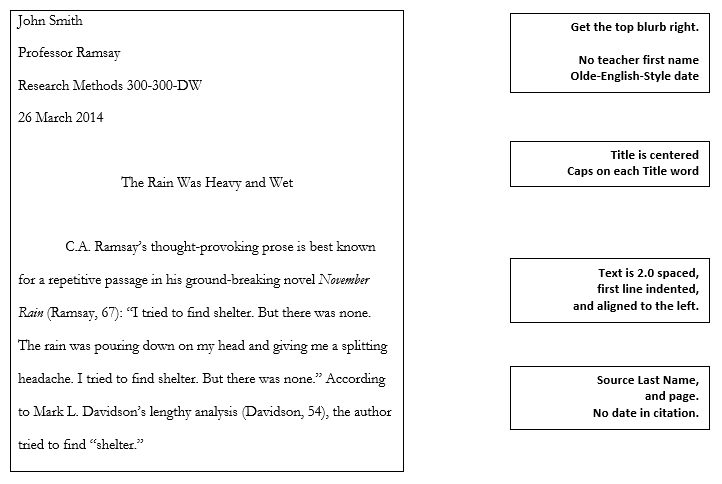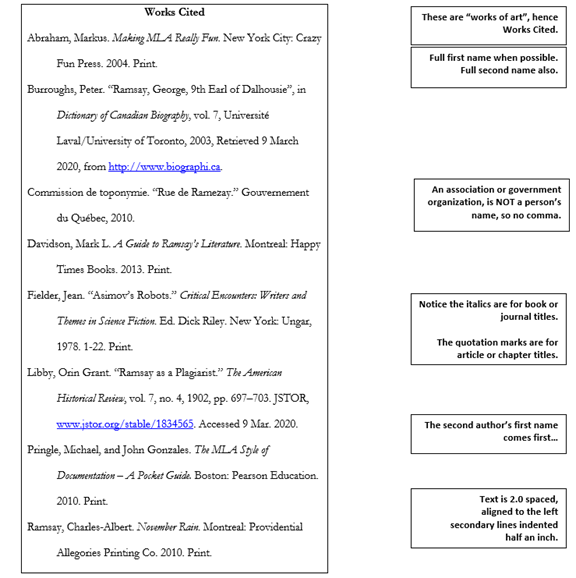MLA Style
Why Should I Care?
Some journals (and academics in that same field) use the MLA style, which is useful to know. Many teachers in college and university will expect papers to be produced using the MLA style.
The Basics
MLA stands for Modern Literature Association. This association of English literature professors across thousands of universities share a common style for the publishing of papers, which can be fiction, prose or poetry, or literary analysis, such as comparative essays.
It is known to be a very short format, without a cover page.
The style is also used by many historians, anthropologists, and many other disciplines in the humanities. If the text is not fiction, there is a specific style for citations (paraphrase and quote).
Here is the complete set of guidelines published by Dawson College for the MLA style. http://www.dawsoncollege.qc.ca/academic-skills-centre/handouts/
The Format
- In the top right header space,
- In the top left corner, four lines, single space,
- Citations include Last Name and Page, in parenthesis.
Dos
- Olde-English style date
- Title is centered
- Caps on each Title word
- Text is 2.0 spaced, first line indented, and aligned to the left.
Don'ts
- Teacher First Name
- Modern date with comma
- Cover page
- Use bold
|
Smith 1 John Smith Professor Ramsay Research Methods 300-300-DW 26 March 2014 The Rain Was Heavy and Wet, An Analysis C.A. Ramsay’s thought provoking prose is best known for a repetitive passage in his ground-breaking novel November Rain ( (...) |
Here are some variations of citations in MLA style.
Version 1 - quote
According to a lengthy analysis of Ramsay's work (Davidson,Davidson 54), the author tried to find “shelter.”
Version 2 - quote
Davidson provides a lengthy analysis of Ramsay's work. He believes Ramsay was trying to "find shelter” (54).
Version 3 - paraphrase
Davidson, based on a lengthy analysis of Ramsay's work, believes Ramsay was trying to find shelter (54).
The Bibliography
- The documents are often “works of art”, hence the title Works Cited.
Last Name, First Name. Book Title. City: Publishing Company. YYYY. Type of document.
(This version lacking hanging indent).
|
Works Cited
Abraham, Markus. Making MLA Really Fun. Burroughs, Peter. ‘‘Ramsay, George, 9th Earl of Dalhousie’’, in Dictionary of Canadian Biography, vol. 7, Université Laval/University of Toronto, 2003, Retrieved 9 March 2020, from http://www.biographi.ca. Commission de toponymie. “Rue de Ramezay.” Gouvernement du Québec, 2010. Web. Davidson, Mark L. A Guide to Ramsay’s Literature. Fielder, Jean. “Asimov’s Robots.” Critical Encounters: Writers and Themes in Science Fiction. Ed. Dick Riley. Libby, Orin Grant. “Ramsay as a Plagiarist.” The American Historical Review, vol. 7, no. 4, 1902, pp. 697–703. JSTOR, www.jstor.org/stable/1834565. Accessed 9 Mar. 2020. Pringle, Michael, and John Gonzales. The MLA Style of Documentation – A Pocket Guide. Ramsay, Charles-Albert. November Rain. |
Dos
- Full Last name, then full First Name when known
- Alphabetical order
- Text is 2.0 spaced, aligned to the left, secondary lines indented half an inch
- Italics for book title or journal titles
- Quotation marks are for article or chapter titles
- For 2 more authors, the last author's name is in the order First Name Last Name
- Include the database and retrieval date if the document is from an online source
- Include the url address if the document is from a website
- If the author is unknown, use the organization as the author, for the bibliography and the text citations
Don'ts
- If using the organization's name as author, do not split the name with a comma
- Use & (ampersand)
- Use parenthesis for the date
- Forget the hanging indent
- Change the order of the authors within a publication
- Don't mistake an Editor for a chapter author


